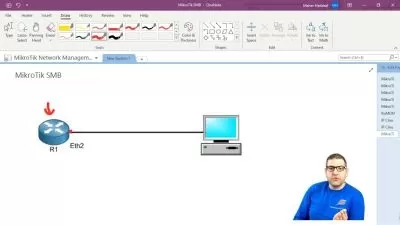MikroTik RouterOS Layer 3 Hardware Offloading with VLANs
Maher Haddad
1:19:32
Description
Understand how to configure Layer 3 Hardware offloading on RouterOS to reduce the CPU usage on your MikroTik device
What You'll Learn?
- Understand what is Layer 3 Hardware Offloading on MikroTik RouterOS and its benefit
- Configure properly Layer 3 Hardware Offloading on MikroTik with VLANs
- Be able to reduce the CPU usage on the MikroTik RouterOS using Layer 3 Hardware Offloading
- Apply the same LAB on your MikroTik router to benefit from the Layer 3 Hardware Offloading
Who is this for?
What You Need to Know?
More details
DescriptionA non-ending complaint that I always get from many ISP's engineers: the CPUÂ on my MikroTik core router is getting too high when the traffic has been increased. Even some say that the MikroTik Routerboard has crashed due to the high traffic because them a lot of problems to their customers.
Do you have also this problem? If yes, then you are not the only one facing this issue. But I have a good news for you that MikroTik company has addressed this problem and provided to us a solution to reduce the CPU usage using the Layer 3 Hardware Offloading feature starting RouterOS version 7, and that's what I am going to show you in this course.
Of course most ISPs use VLANs in their core network, and they require to make the Layer 3 Hardware Offloading workable with VLANs, and that's exactly what I am going to do in this course.
In the first part of the course, I am going to explain to you what is the Layer 3 Hardware Offloading, what is its advantages/disadvantages, and which MikroTik Routerboard models can be used for the Layer 3 Hardware Offloading.
Once done with that part, I will show you in a LAB how the CPU on the core MikroTik router will go high on very high traffic when Layer 3 Hardware Offloading is not enabled.
Then, I will show you in another LAB how to enabled Layer 3 Hardware Offloading with VLANs on MikroTik RouterOS, and will redo the test by sending high traffic and will check if the CPU on the core router will go lower.
That's all what we will be done in this course, just focusing on 1 topic which is Layer 3 Hardware Offloading with VLANs.
By end of this course, you will have the complete knowledge how to run Layer 3 Hardware Offloading with VLANs in your production network and you finish from the high CPU usage on your MikroTik Routerboard when high traffic is being used.
IÂ see you in the course.
Who this course is for:
- Engineers working in ISPs and WISPs
- MikroTik Routing Engineers
- ISPs and WISPs' owners
A non-ending complaint that I always get from many ISP's engineers: the CPUÂ on my MikroTik core router is getting too high when the traffic has been increased. Even some say that the MikroTik Routerboard has crashed due to the high traffic because them a lot of problems to their customers.
Do you have also this problem? If yes, then you are not the only one facing this issue. But I have a good news for you that MikroTik company has addressed this problem and provided to us a solution to reduce the CPU usage using the Layer 3 Hardware Offloading feature starting RouterOS version 7, and that's what I am going to show you in this course.
Of course most ISPs use VLANs in their core network, and they require to make the Layer 3 Hardware Offloading workable with VLANs, and that's exactly what I am going to do in this course.
In the first part of the course, I am going to explain to you what is the Layer 3 Hardware Offloading, what is its advantages/disadvantages, and which MikroTik Routerboard models can be used for the Layer 3 Hardware Offloading.
Once done with that part, I will show you in a LAB how the CPU on the core MikroTik router will go high on very high traffic when Layer 3 Hardware Offloading is not enabled.
Then, I will show you in another LAB how to enabled Layer 3 Hardware Offloading with VLANs on MikroTik RouterOS, and will redo the test by sending high traffic and will check if the CPU on the core router will go lower.
That's all what we will be done in this course, just focusing on 1 topic which is Layer 3 Hardware Offloading with VLANs.
By end of this course, you will have the complete knowledge how to run Layer 3 Hardware Offloading with VLANs in your production network and you finish from the high CPU usage on your MikroTik Routerboard when high traffic is being used.
IÂ see you in the course.
Who this course is for:
- Engineers working in ISPs and WISPs
- MikroTik Routing Engineers
- ISPs and WISPs' owners
User Reviews
Rating
Maher Haddad
Instructor's Courses
Udemy
View courses Udemy- language english
- Training sessions 8
- duration 1:19:32
- Release Date 2025/03/04










